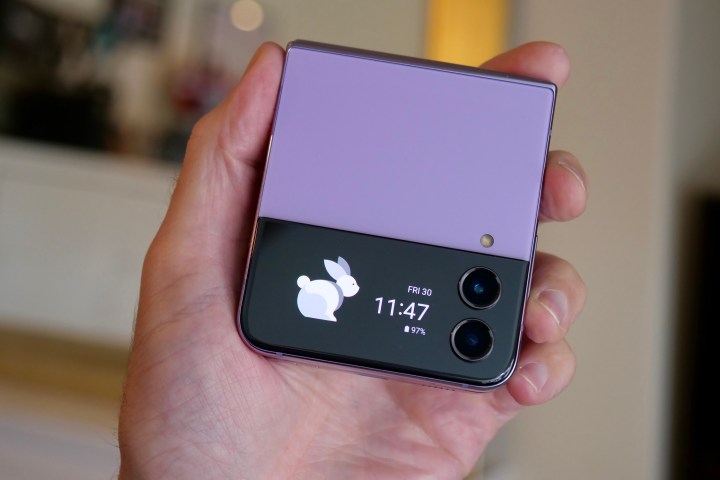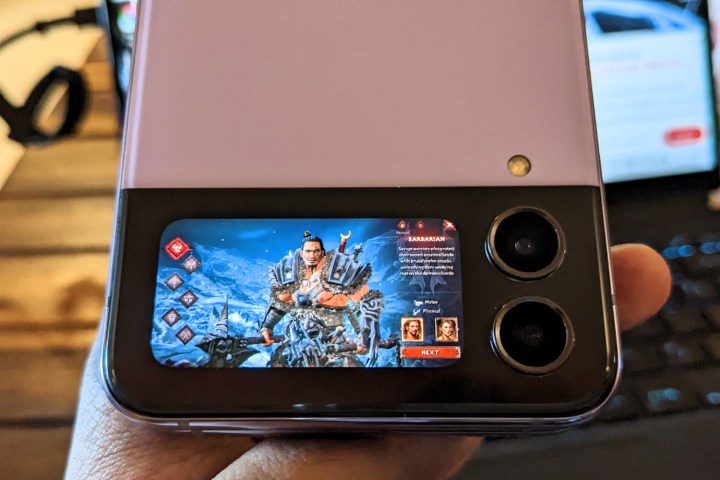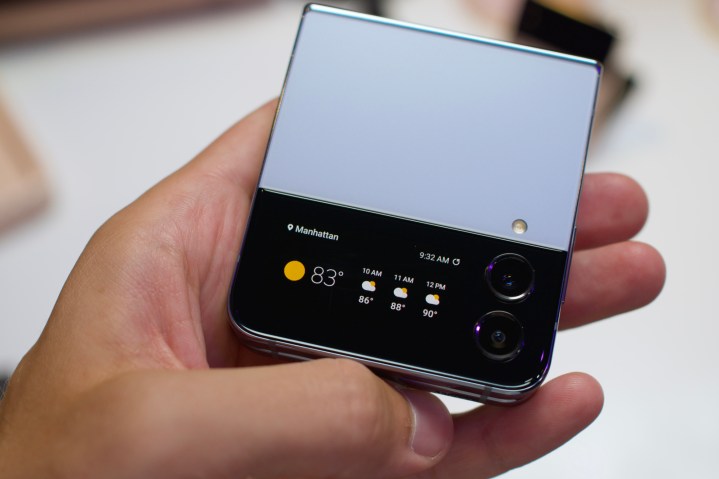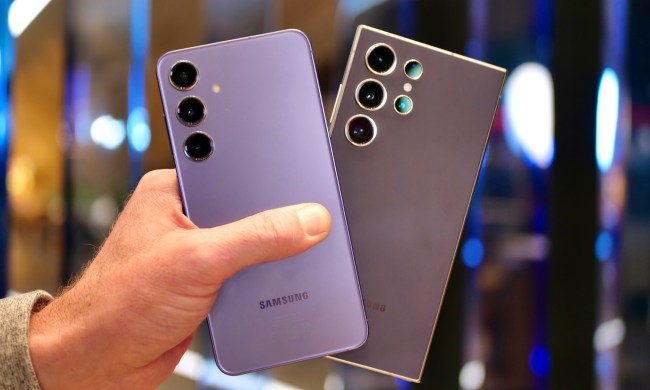Samsung’s latest foldables were far from its best-kept secrets. They were repeatedly spoiled by a barrage of leaks that left barely anything to our imagination. While that may have dampened the excitement for the Samsung Galaxy Z Flip 6 and the Galaxy Z Fold 6, the phones still look promising and feature upgraded designs, better cameras, improved performance, and a sweeping range of AI features.
- Galaxy Z Flip 6 vs. Galaxy Z Flip 4: specs
- Galaxy Z Flip 6 vs. Galaxy Z Flip 4: design
- Galaxy Z Flip 6 vs. Galaxy Z Flip 4: display
- Galaxy Z Flip 6 vs. Galaxy Z Flip 4: performance
- Galaxy Z Flip 6 vs. Galaxy Z Flip 4: battery and charging
- Galaxy Z Flip 6 vs. Galaxy Z Flip 4: cameras
- Galaxy Z Flip 6 vs. Galaxy Z Flip 4: software and updates
- Galaxy Z Flip 6 vs. Galaxy Z Flip 4: price and availability
- Galaxy Z Flip 6 vs. Galaxy Z Flip 4: verdict
The Galaxy Z Flip 6 doesn’t offer many significant upgrades compared to the Flip 5. However, if you currently have the Galaxy Z Flip 4 or an older Flip model and are considering an upgrade, the Galaxy Z Flip 6 is worth your attention. We’ll discuss how the Galaxy Z Flip 6 compares to the Flip 4 and help you decide if the larger outer display, improved processor, and enhanced AI capabilities are compelling enough reasons to upgrade.
Galaxy Z Flip 6 vs. Galaxy Z Flip 4: specs
| Specs | Samsung Galaxy Z Flip 6 | Samsung Galaxy Z Flip 4 |
|---|---|---|
| Size | Folded: 85.1 x 71.9 x 14.9 mm (3.35 x 2.83 x 0.62-0.67 inches) Unfolded: 165.1 x 71.9 x 6.9 mm (6.50 x 2.83 x 0.27 inches) |
Folded: 84.9 x 71.9 x 15.9-17.1 mm (3.34 x 2.83 x 0.62-0.67 inches) Unfolded: 165.2 x 71.9 x 6.9 mm (6.50 x 2.83 x 0.27 inches) |
| Weight | 187 grams (6.59 ounces) | 187 grams (6.59 ounces) |
| Screen |
|
|
| Operating system | One UI 6.1.1 with Android 14 | Upgradable to One UI 6.1 with Android 14 |
| RAM & Storage |
|
|
| Processor | Qualcomm Snapdragon 8 Gen 3 | Qualcomm Snapdragon 8+ Gen 1 |
| Camera |
|
|
| Video |
|
|
| Connectivity |
|
|
| Ports | USB-C (USB version not specified) | USB-C (USB 2.0) |
| Water resistance | IP48 | IPX8 (no specified dust resistance) |
| Battery & charging |
|
|
| Colors | Silver Shadow, Yellow, Blue, Mint Samsung.com exclusive colors: Black, White, Peach |
Bora Purple, Graphite, Pink Gold, Blue, Yellow, White, Navy, Khaki, Red |
| Price | Starting at $1,100 | Initial launch price $1,000 |
Galaxy Z Flip 6 vs. Galaxy Z Flip 4: design

The Galaxy Z Flip lineup underwent major design changes with the Galaxy Z Flip 5, and they stayed with the new Flip 6. Most visible changes on the Galaxy Z Flip 6 compared to the Flip 4 include a much larger cover display, which occupies a bigger section of the upper face, and a negligible gap between the folded halves of the phone. The lack of a gap is attributed to a redesigned hinge that anchors the two folding sides together.
When unfolded, the dimensions, thickness, and weight of the Galaxy Z Flip 6 are identical to those of the Flip 5 and the Flip 4. However, after removing the gap lap last year, Samsung has managed to shave 2mm off the thickness in the folded state, making it the thinnest Galaxy Z Flip phone yet. It’s also slimmer than the recently announced Motorola Razr Plus 2024.

Samsung flattened the frame on the sides last year, and not much has changed in that regard, besides the finish being matte rather than glossy. If you are transitioning from the Galaxy Z Flip 4, you might miss the rounder side rails (or you might actually prefer the sharper, flatter ones on the Galaxy Z Flip 6, depending on your preference), as our reviewer did. The Flip 6 also does not include the titanium frame that the Galaxy S24 Ultra received earlier this year.
A minor change now headed to the Flip is the new accent rings around the cameras, now color-coordinated with the color of the phone. Samsung is also offering a wide range of vibrant and dandy case options, called “suit-cases,” some of which even light up like your private positivity-professing billboards.

A significant alteration comes in the form of the newly conferred IP rating. The previous generations of the Galaxy Z Flip came with an IPX8 rating, where the 8 signifies strong resistance to water, and the X suggests that the phone has not been tested for its resistance to dust or fine granular particles. It changes with the Galaxy Z Flip 6, which now features an IP48 rating.
As per the international body that assigns these IP ratings, a solid particle resistance of 4 (on a scale of 0 to 6) indicates the device is safe against solids larger than 1 millimeter in diameter. This still means the phone is susceptible to damage from finer particles of dust or debris (which might get stuck between the fold or under the folding display). However, the level 4 rating adds a sense of assurance that the previous Flips lacked.
Other than these minor design improvements, there is no major change on the outside of the Galaxy Z Flip 6, which leads us to the next aspect — the display.
Galaxy Z Flip 6 vs. Galaxy Z Flip 4: display

Similar to the design, which only brings functional improvements instead of radical modifications, the inner display on the Galaxy Z Flip 6 remains largely unchanged from previous generations. The Flip 6 features the same 6.7-inch Full HD+ display we have seen on the Flip 5 and the Flip 4, with features including dynamic refresh rate.
The only noticeable change over previous generations is the inner display’s brightness, now with a whopping value of 2,600 nits for the peak brightness — compared to the relatively unimpressive 1,200 nits on the Flip 4 or 1,600 nits on the Flip 5. This increment ensures significantly better visibility outdoors and richer contrast while watching video content with HDR.
The bigger improvement lies in the cover display, which was upgraded from the tiny and restrictive 1.7-inch section on the Galaxy Z Flip 4 to a much larger square-shaped 3.4-inch display on the Flip 5. The same display carries over to the Flip 6 without any noticeable improvements — and still feels less impressive than the encompassing cover display on the Motorola Razr 2024 series.

To help its case, Samsung has added new interactive wallpapers for the cover screen, which respond to taps and the movements of the phone. It also includes new widgets. Considering these are software features, we expect them to also be available on the Galaxy Z Flip 5, though we can’t guarantee it.
The larger outer display makes this upgrade seriously worth it. Moreover, Samsung also lets you run full-screen apps on the cover display without opening the phone with some
Galaxy Z Flip 6 vs. Galaxy Z Flip 4: performance

With a newer and significantly more powerful chipset under the hood, you can expect the Galaxy Z Flip 6 to outperform the Flip 4 by a large margin. The Flip 6 packs a Snapdragon 8 Gen 3, which is mighty as compared to the Snapdragon 8+ Gen 1 on the Flip 4. In addition to faring better in performative tasks, the Snapdragon 8 Gen 3 is also equipped to run on-device AI applications, including Samsung’s own suite of programs part of One UI.
The performance boost will be evident as compared to the two-year-old device, not only because of the chip but also because of the improved RAM and storage. The Galaxy Z Flip 6 is the first phone in the series to feature 12GB of onboard RAM, which now comes as standard across all storage options.

Speaking of storage, the Galaxy Z Flip 6 starts with a base 256GB variant, compared to the 128GB on the Flip 4. The storage technology is upgraded, too. It now relies on a faster UFS 4.0 protocol, which translates to quicker loading of apps and better performance while gaming or using the camera, besides faster file transfers.
Apart from these improved components, the Galaxy Z Flip 6 is the first phone in the series to get a vapor cooling chamber. Samsung says the chamber is 50% larger than the one on the Galaxy S23 series — or practically the same as Galaxy S24 devices. The vapor cooling chamber allows for faster dissipation of heat generated from the internal hardware by distributing it across the body.
The vapor chamber’s addition can be expected to ward off heat accumulation in scenarios such as extended video recording, wireless charging, or continuous use of GPS for navigation. This, in turn, would reduce thermal throttling — an issue that plagues most of the older Galaxy Z Flip devices.

Additionally, the Galaxy Z Flip 6 features a newer cellular modem with better connectivity. It also comes with an advanced Wi-Fi component that will support the newer Wi-Fi 6E protocol, although without tri-band support. This could translate to faster Wi-Fi speeds and lower latency, assuming you have a compatible Wi-Fi 6E router.
Galaxy Z Flip 6 vs. Galaxy Z Flip 4: battery and charging

Battery is one area where the Galaxy Z Flip series has laggedbehind other similarly sized phones in more traditional designs. With each iteration, Samsung has been bumping up the battery capacity, and the Galaxy Z Flip 6 gets yet another update. It now features a 4,000mAh battery, with a roughly 8% increment over the 3,700mAh pack on Flip 5 and Flip 4. Samsung isn’t pushing any AI features that may improve the battery’s performance, but the chipset is more power efficient, which can result in slightly better backup. Unfortunately, this is still a one-day battery.
Charging speeds also haven’t changed between the Galaxy Z Flip 4 and Galaxy Z Flip 6. The Flip 6 supports wired charging at 25W and can charge wirelessly at a maximum rate of 15W using a Samsung (or certified) charger. Meanwhile, there’s no clarity about support for Qi2 wireless charging protocol on the Galaxy Z Flip 6.

Additionally, you can charge accessories such as wireless earbuds using the reverse wireless charging feature, for which the Galaxy Z Flip 6 supports a maximum output of 4.5W. It can also charge phones with wireless charging, albeit slowly.
While the charging speeds haven’t been improved, the Galaxy Z Flip 6’s new vapor chamber will ensure the phone cools better while charging. It should prevent the rate of charging from dropping due to heat accumulating inside the body.
Galaxy Z Flip 6 vs. Galaxy Z Flip 4: cameras

The camera is one of the areas where most foldables don’t shine bright (though this Vivo Fold defies that notion), but Samsung is set out to change it this year. While the Fold 6 is getting new ultrawide and telephoto cameras, the Galaxy Z Flip 6 gets a new 50MP primary camera, which is the same as the Galaxy S24 and the S24 Plus phones. As we noticed in our Galaxy S24 Plus review, the primary camera has good results and has been optimized for natural color reproduction. In certain scenarios, especially with moving objects or in low light, the camera may result in unsatisfactory results.
While the Galaxy Z Flip 6’s cameras may still feel short compared to other phones selling for over $1,000, there is a considerable improvement over the Galaxy Z Flip 4 or even the Flip 5. Besides the primary 50MP camera, there is a new 12MP sensor under the ultrawide lens, but we aren’t sure of the exact changes. The under-display selfie camera on the Flip 6 has a slightly wider opening, resulting in marginally better photos. Of course, you can use the outer cameras for selfies by using the cover screen as the viewfinder.

In addition to the improved sensors, the Snapdragon 8 Gen 3’s underlying image signal processor (ISP) should result in more refined images overall. We will test both of these new cameras during our review and update this section accordingly.
In terms of videos, both the Galaxy Z Flip 6 and the Flip 4 can record 4K videos at up to 60 frames per second. The larger sensor on the former is likely to improve the sharpness and color reproduction on videos, but not by a long margin. While the chipset supports 8K video recording, the phones skip out, probably due to the propensity to heat up quickly. Both phones also support a handycam mode, where you can bend them roughly at 90 degrees and shoot videos with an adjustable viewfinder.
Galaxy Z Flip 6 vs. Galaxy Z Flip 4: software and updates

Samsung has been bullish on AI features that were introduced with the Galaxy S24 series and gradually rolled out to older devices. The Galaxy Z Flip 6 will arrive with those standard Galaxy AI features, including Circle to Search and Live Translate. Certain other features under the umbrella of Samsung’s ProVisual Engine use AI to enhance shots by choosing the right frame, improving lighting, or focusing on faces in the frame. Other features specific to the Galaxy Z Flip 6 include AI-ficiation of the cover screen’s wallpapers, giving them a 3D effect.
Some of these basic features have either already trickled down to the Galaxy Z Flip 4 or are expected to reach it soon. Apart from these, there are no major differences between the Galaxy Z Flip 6 and the Flip 4 in terms of the software experience. Both run the One UI 6.1 interface based on Android 14.
The Galaxy Z Flip 4 was promised five years of software updates from its launch in August 2022. Meanwhile, the Galaxy Z Flip 6 gets seven years of updates starting from its July 2024 launch.
Galaxy Z Flip 6 vs. Galaxy Z Flip 4: price and availability

Another stark difference between the Galaxy Z Flip 6 and the Flip 4 is their prices. The Flip 6 has a $1,100 starting price (256GB storage), which aligns with the $1,000 initial pricing for the 128GB variant of the Flip 4.
While Samsung no longer has stock for the Galaxy Z Flip 4, you can find unofficial sellers on Amazon (or a physical store near you) selling it for . Some refurbished models can even be bought for — but make sure to check support for your carrier in the product’s listing.
In comparison, the new Galaxy Z Flip 6 is available for $1,100, and Samsung is offering a free-of-charge storage upgrade to 512GB if you preorder before July 24. Samsung will even offer you hefty trade-in credits, with $550 off if you exchange your old Flip 4 for the new Flip 6, along with tempting discounts on accessories such as the new Galaxy Buds 3 Pro.
Galaxy Z Flip 6 vs. Galaxy Z Flip 4: verdict

The Galaxy Z Flip 5 was a major upgrade over the Galaxy Z Flip 4 from the previous year, especially because of the larger, more functional cover display. This year, while the cosmetic improvements are limited, a new chipset, improved cameras, a bigger battery, and the promise of longer software support make the Samsung Galaxy Z Flip 6 even more appealing.
Whether you have been using the Flip 4 and are looking to upgrade to a better Flip or have just been a fan of the form factor, the Z Flip 6 is a reasonable upgrade. The added accessory lineup makes the phone even more flaunt-worthy. That said, if your Flip 4 functions without any hiccups, you may as well wait for the Galaxy Flip 7, as it could feature an overhauled design.
If you aren’t restricting yourself to just Samsung, the Motorola Razr Plus 2024 is a worthy alternative with a better display, arguably better cameras, and even faster charging. But you lose out on Samsung’s consistent software updates and the promise of endearing software support that will likely outlast most of its competition.



